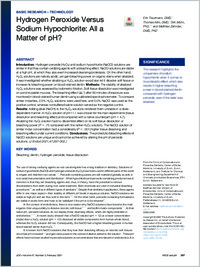Hydrogen Peroxide Versus Sodium Hypochlorite: All a Matter of pH?
- Trautmann E Clinic of Conservative and Preventive Dentistry, Center of Dental Medicine, University of Zurich, Zurich, Switzerland.
- Attin T Clinic of Conservative and Preventive Dentistry, Center of Dental Medicine, University of Zurich, Zurich, Switzerland.
- Mohn D Clinic of Conservative and Preventive Dentistry, Center of Dental Medicine, University of Zurich, Zurich, Switzerland; Department of Chemistry and Applied Biosciences, Institute for Chemical and Bioengineering, ETH Zurich, Zurich, Switzerland.
- Zehnder M Clinic of Conservative and Preventive Dentistry, Center of Dental Medicine, University of Zurich, Zurich, Switzerland. Electronic address: matthias.zehnder@zzm.uzh.ch.
- 2020-11-01
Published in:
- Journal of endodontics. - 2020
English
INTRODUCTION
Hydrogen peroxide (H2O2) and sodium hypochlorite (NaOCl) solutions are similar in that they contain oxidizing agents with a bleaching effect. NaOCl solutions are stable at a high pH, at which they also exert increased cleansing/proteolysis. On the other hand, H2O2 solutions are natively acidic, yet gain bleaching power on organic stains when alkalized. It was investigated whether alkalizing a H2O2 solution would also let it dissolve soft tissue or increase its bleaching power on blood-stained dentin.
METHODS
The stability of alkalized H2O2 solutions was assessed by iodometric titration. Soft tissue dissolution was investigated on porcine palatal mucosa. The bleaching effect (ΔL∗) after 60 minutes of exposure was monitored in blood-stained human dentin using a calibrated spectrophotometer. To compare similar molarities, 2.5% H2O2 solutions were used here, and 5.0% NaOCl was used as the positive control, whereas nonbuffered saline solution served as the negative control.
RESULTS
Adding alkali (NaOH) to the H2O2 solutions rendered them unstable in a dose-dependent manner. A H2O2 solution of pH 11.1 was chosen for the main experiments (tissue dissolution and bleaching effect) and compared with a native counterpart (pH = 4.7). Alkalizing the H2O2 solution had no discernible effect on its soft tissue dissolution or bleaching power (P = .75 compared with the native H2O2 solution). The NaOCl solution of similar molar concentration had a considerably (P < .001) higher tissue dissolving and bleaching effect under current conditions.
CONCLUSIONS
The proteolytic/bleaching effects of NaOCl solutions are unique and cannot be achieved by altering the pH of peroxide solutions.
Hydrogen peroxide (H2O2) and sodium hypochlorite (NaOCl) solutions are similar in that they contain oxidizing agents with a bleaching effect. NaOCl solutions are stable at a high pH, at which they also exert increased cleansing/proteolysis. On the other hand, H2O2 solutions are natively acidic, yet gain bleaching power on organic stains when alkalized. It was investigated whether alkalizing a H2O2 solution would also let it dissolve soft tissue or increase its bleaching power on blood-stained dentin.
METHODS
The stability of alkalized H2O2 solutions was assessed by iodometric titration. Soft tissue dissolution was investigated on porcine palatal mucosa. The bleaching effect (ΔL∗) after 60 minutes of exposure was monitored in blood-stained human dentin using a calibrated spectrophotometer. To compare similar molarities, 2.5% H2O2 solutions were used here, and 5.0% NaOCl was used as the positive control, whereas nonbuffered saline solution served as the negative control.
RESULTS
Adding alkali (NaOH) to the H2O2 solutions rendered them unstable in a dose-dependent manner. A H2O2 solution of pH 11.1 was chosen for the main experiments (tissue dissolution and bleaching effect) and compared with a native counterpart (pH = 4.7). Alkalizing the H2O2 solution had no discernible effect on its soft tissue dissolution or bleaching power (P = .75 compared with the native H2O2 solution). The NaOCl solution of similar molar concentration had a considerably (P < .001) higher tissue dissolving and bleaching effect under current conditions.
CONCLUSIONS
The proteolytic/bleaching effects of NaOCl solutions are unique and cannot be achieved by altering the pH of peroxide solutions.
- Language
-
- English
- Open access status
- hybrid
- Identifiers
-
- DOI 10.1016/j.joen.2020.10.016
- PMID 33129899
- Persistent URL
- https://folia.unifr.ch/global/documents/118521
Statistics
Document views: 36
File downloads:
- fulltext.pdf: 0
